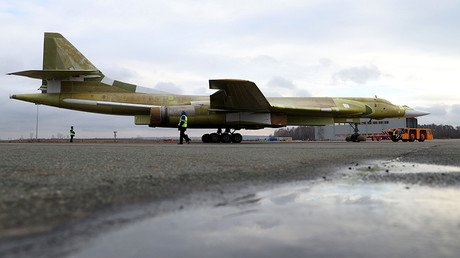Nein, thanks: Germany snubs F-35, new fighter choice still up in air
Luftwaffe is not interested in the American F-35 jet as a replacement for its aging Tornado fleet, but Boeing’s F-18 might still be picked over the Eurofighter Typhoon due to its nuclear capabilities required by NATO.
Lockheed Martin’s fifth-generation jet is no longer in the running for the contract, German officials confirmed on Thursday, also ruling out the older US-made F-15. The final decision on which jet makes it to the German air bases has not been made, however, as there are both political and operational factors under consideration.
While the Luftwaffe is eager to replace its 80-some Tornado jets, in service since 1983, they are not quite desperate enough to opt for the expensive and troubled Lightning II. The most recent estimates put that program’s lifetime cost in the US at around $1.5 trillion, give or take a billion or twenty. Even that wouldn’t be so problematic if the ambitious weapons platform actually worked as intended, which it unfortunately does not.
Also on rt.com WATCH ‘Russian’ Su-27 fend off F-15 in a daring maneuver mid-airThe Tornado, developed in the 1970s by an Anglo-Italian-German consortium, is fast approaching the end of its service life. Maintaining the existing planes is costing Germany billions of euros, which the defense ministry feels should be used to buy newer, better planes.
The contest now pits aviation giants Boeing and Airbus against each other. Boeing’s F/A-18 Super Hornet, currently in service with the US Navy, is a reliable workhorse certified to carry US nuclear weapons that Germany is hosting under a NATO strategic posture arrangement. Incidentally, acting US Defense Secretary Patrick Shanahan is a former Boeing executive.
Airbus is the lead partner in the consortium making the Eurofighter Typhoon, a 1990s design in use with several NATO countries as well as Kuwait, Oman, Qatar and Saudi Arabia. However, the US has yet to certify the jet for nuclear ordnance, which might work against its adoption by the Luftwaffe.
Germany has expressed the desire to develop a fifth-generation fighter in cooperation with France, but that project is not supposed to kick off until the 2030s, while the Tornadoes will need to be retired by 2025.
Last year, Lieutenant General Karl Müllner resigned as the Luftwaffe’s chief of staff - reportedly because his support for the American design clashed with the desire of Chancellor Angela Merkel’s government for a “European solution.”
Also on rt.com Pentagon hiding ‘life-threatening’ F-35 design flaws to meet deadline – watchdogGermany’s decision is a blow to the F-35, once billed by Lockheed as a multipurpose, modular design that could replace all other fighter jet models. In practice, the manufacturer had to build three distinctive designs, including a vertical takeoff model for the Marines and a carrier version for the Navy, that drastically raised the price of the program. Although technically in service with all three branches, the F-35 continues to suffer from mechanical and software glitches.
Some of the earlier F-35Bs of the Marines Corps may need to be retired from service as soon as 2026, after flying for only 2,000 hours or so, Aviation Week reported recently. The project documentation called for the capability of at least 8,000 hours, but the earlier production units were reportedly built to less demanding specifications in order to get them into service faster.
Like this story? Share it with a friend!














